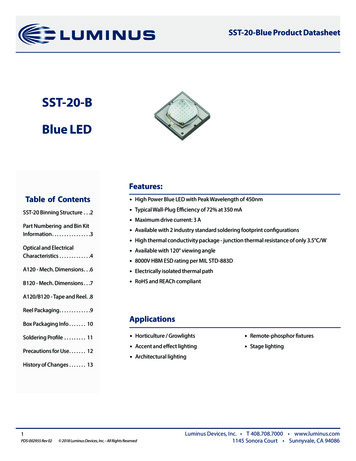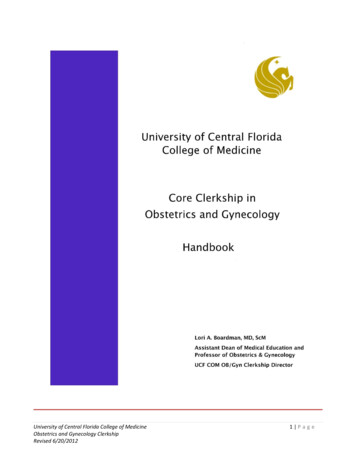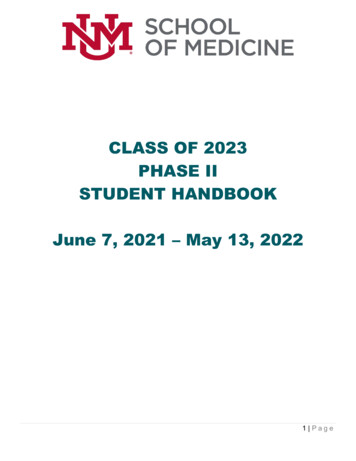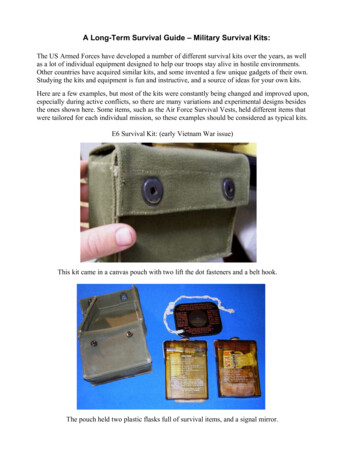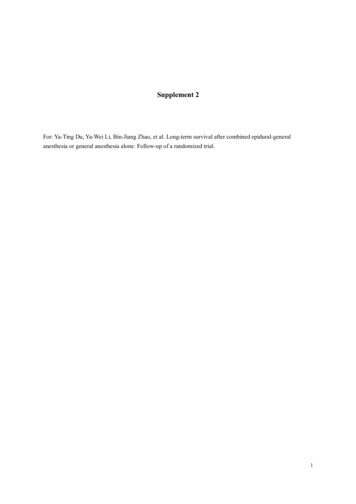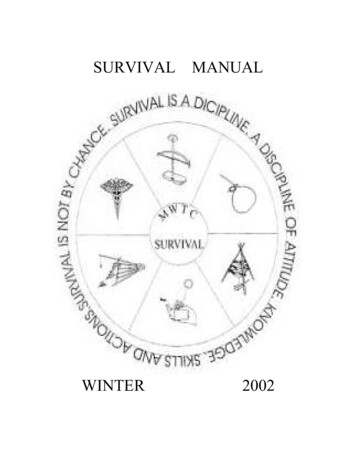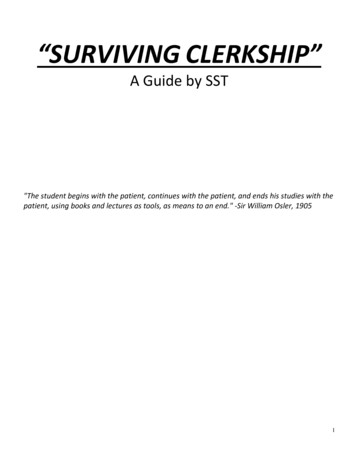
Transcription
“SURVIVING CLERKSHIP”A Guide by SST"The student begins with the patient, continues with the patient, and ends his studies with thepatient, using books and lectures as tools, as means to an end." -Sir William Osler, 19051
Prior Authors & Editors:Paul Healey ’00 & Rupinder Sahsi ‘00Darren Cargill ‘03 & George Kim ‘03Mark Matsos ’04, Tomas Jimenez ’04Jesse Shantz ‘05, Sumon Chakrabarti ‘05Kris Croome ‘06Mike Zettler ‘10Krista Margeson ‘14, Jon Gregory ‘14Note: Much of the work for this “Clerkship Survival Guide” has been done by our predecessors listedabove. We have compiled multiple documents and edited the particulars that have changed (e.g. theformat of exams and the on-call responsibilities of clerks) with the hope that you will find this very usefulnext year. You are all going to make amazing clerks.Enjoy your year!Sincerely,Graham Bergstra and Andrea Cowan (Class of 2015)2
CONTENTS Preface: Rules of Clerkship A Guide To Useful Resources For Clerkship Smartphone Useful Books Online Resources An Approach to the Many Types of Rounds Guide To Writing Notes Admission Note format Progress Note format Discharge Dictation Format and Discharge Summary Guide to Writing Orders Approach To Admission/Transfer Orders Ordering Drugs and Writing Prescriptions Common Order Pitfalls Sample Orders Frequently Used Abbreviations The LHSC/SJHC Paging System at a Glance ROTATION TIPS: Medicine Rotation Family Rotation Psychiatry Rotation Paediatrics Rotation Obstetrics & Gynecology Rotation Surgery Rotation3
RULES OF CLERKSHIPfrom “The House of God” by Samuel Shem1.2.3.4.5.6.7.8.Never stand when you can sit.Never sit when you can lie down.Eat when you can.Sleep when you can.F#@& when you can.Never lie to your senior.Never let them see you eating or sleeping.If you enjoy your free time, never spend any of it within line of site of the nursing station, or it won’tbe free for long.9. Never buy an expensive pen, your consultant will steal it.10. Nobody ever gets in sh*t for showing up on time.11. When nature calls, make sure you’re listening.12. You can’t go wrong by going to see the patient.13. Know your patient better than anyone else does.14. Caffeine is your friend.15. Medicine is a team sport. Be a team player.16. If you don’t take a temperature, you can’t find a fever.17. Never pass up free food.18. Never skip a teaching session, or it will inevitably show up all over your exam.19. Don’t get the patient’s bed dirty.20. Nobody likes a miserable clerk.21. Never upstage your colleagues, especially at rounds, no matter how good you think you’ll look.22. If you’re scrubbed in a) make sure the field is well lit, b) have the suture scissors ready BEFORE you’retold to cut, c) suck the smoke.23. Never fudge a finding.24. Never piss off people senior to you, it will come back to haunt you.25. Read something every day.26. Follow the chain of command.27. Take your pulse first (in a panic situation, make sure you’re calmed down and thinking clearly)28. If anyone suggests, hints, or alludes to you possibly, maybe, potentially going home/taking abreak/getting a meal don’t think about it THANK THEM AND GO!29. When a code is called, clerks traditionally have three roles 1) get the gawkers out of the room, 2)make sure the chart is handy, 3) fight the urge to run around screaming “whatdoIdowhatdoIdo ”30. Never miss any rounds sponsored by a drug company.31. You’re no good to anyone if you’re still asleep (when you’re paged in the middle of the night, giveyourself 30 seconds to wake up before slurring your speech into the telephone).32. Don’t try to be a hero. Know when you’re over your head.33. Never talk about patients in public areas. You never know who’s listening.34. Never talk about staff in public areas. You never know who’s listening.35. “Sure, I’d love to do that rectal exam for you.”36. Make your seniors look good, and they’ll make you look good.37. You make a mess, you clean up the mess.38. Get a life!4
A GUIDE TO USEFUL RRESOURCES FOR CLERKSHIPThe decision of what books to buy in clerkship is controversial. Most medical students already have a wideassortment that will serve them well. These days, many of you will be studying online copies of textbooks onyour laptop/iPad and using a smartphone instead of pocket references.We advise basing your decision to buy books on what specialty you plan to enter and how much time you willactually spend reading during clerkship. Each rotation will present you with a list of their own departmentalrecommendations – some good, some not so good. Also remember, if you are hesitant about paying moneyfor new books before getting a good look at them, try searching the UWO library system or borrowing from afriend. There are plenty of free resources available!1. SMARTPHONEBack in the day, clerks would carry around tons of pocket textbooks with guides to all the drugs and medicalconditions. Now? You have access to tons of apps and any website within seconds from the palm of yourhand. However, don’t feel like you have to get a smartphone just for clerkship - people get through clerkshipwithout it!Must-Have Apps:1. A Drug Reference ToolRecommended: MicromedexFree. Details every drug, its dose, and its indications.2. Quick Reference for Medical ConditionsRecommended: MedscapeFree. Presentation, workup, management.Recommended: DynamedSubscription available for Schulich students. Contact dynamedsupport@ebscohost.comwith your @uwo.ca e-mail address to have a serial number e-mailed to you.Evidence-based point-of-care reference. Will make you look good.c) Medical CalculatorRecommended: Qx CalculateFree. Pretty exhaustive calculator for anything you will need in clerkship.Link to UWO Library Apps:(for Dynamed, Diagnosaurus, Epocrates Rx, MedCalc, Medscape, Micromedex, ch/guidetohandhelddevices.html** UptoDate – Although UptoDate is no longer supplied to students through Schulich, many past clerks havefound it useful to purchase their own subscription. One subscription allows you to download the phone appto two devices, so you can split the cost with a friend. Purchasing UptoDate is by no means necessary forclerkship success and the tools mentioned above are good alternatives. Most students, however who havebought he subscription find that it’s worth the cost and use it frequently on all rotations.5
2. BOOKSStrongly Recommended:The Toronto Notes 150 (including online subscription, textbook, and clinical handbook) This is a handy reference, but is in point form and therefore better for review than learning The clinical handbook is compact and can be very useful on new rotations The online subscription is unfortunately not well-integrated with smartphones but creating asmall PDF of relevant chapters can put the information into a usable format for phonesThe Sanford Guide to Antimicrobial Therapy This small reference book is authoritative for bugs and antibiotics; the next best thing to aface-to-face conversation with an Infectious Disease specialist. It may seem cryptic at first, but if you learn to use it, and use it well, you’ll be better withinfectious diseases than most residents (and some consultants!). Infections are relevant everywhereIf you don't use a smartphone:Tarascon Pocket Pharmacopeia Contains almost all the drugs you will be ordering, their indications, and their CANADIANdosages Not necessary to carry around given the availability of free smartphone apps, but if youprefer to have a hard copy and quick reference for pharmaceuticals, this one is universallyrecommended. It’s also nice to have if you feel self-conscious about pulling out yoursmartphone when people will think you’re texting etc.Other Textbooks Recommended by Prior Classes The Calgary Black Book Care of the Medical Patient The Oxford Handbook of Clinical Medicine Cecil’s Essentials of Internal Medicine Current diagnosis and treatment in Surgery Recall Series On-Call Series (Principles & Protocols, Surgery, Medicine) Lange Casefiles Series NMS Review Series The Intern’s Pocket Survival Guide Essentials of Clinical Examination Handbook (concise guide from U of T) Pocket Medicine (Massachusetts General Hospital Handbook of Internal Medicine) Clinical Microbiology Made Ridiculously SimpleOne of the best resources for finding really good books is your resident(s). See what they would suggest.To save money, share pocket references with classmates who have a different rotation schedule than you do!For more detailed textbook recommendations for each clerkship block, take a look at the specific chapters!6
Most of your clerkship will be spent in centres with ready access to the internet. Being able to access onlineinformation quickly (using a computer or your phone) is a crucial skill to polish. You will likely find it muchmore useful in clinical practice than in the pre-clinical years. Some useful sites for this include: American Academy of Family Physicians – www.aafp.org Quick search of a large library of handy review articles CMA – www.cma.ca Included with your CMA membership is online access to MD Consult as well as OVID online accessto a ton of full text journals (ensure you have your CMA number) Medscape – www.medscape.com Medical news, articles, and a medical student section full of handy resources Emedicine – www.emedicine.com Free, reliable, online textbooks by medical professionals for medical professionals Wikipedia Usually the fastest way to get answers to questions UpToDate Great for evidence-based information, also useful for printing out patient information handoutsAgain, a great way to get access to subscription-only websites is through Western Library's clinical outreachpage: http://www.lib.uwo.ca/programs/clinicaloutreach/7
APPROACH TO THE MANY TYPES OF ‘ROUNDS’There are different types of rounds. Your first day, the resident you are with may say for you to show uptomorrow at 7:00am for “rounds”. Rounds vary somewhat from specialty to specialty with regards to who ispresent (residents and staff vs. residents only) and length (ortho rounds 15 patients in 30 minutes vs.medicine rounds 10 patients in 3 hours). In general, the main forms of rounds are:1. Patient Rounds - this involves seeing patients assigned to your team (there is usually a team list onPowerChart) with the residents and clerks \- consultant, and dealing with any issues left over fromthe evening and making plans for the day. These types of rounds are most often used by surgeryservices. They might also be used on weekends while on Pediatrics and Medicine when there are alarge number of patients to check in on but a smaller team.Clerk’s Role – Consider showing up 10 minutes early to print out the team list for eachresident. The team list can be found on PowerChart, however you usually have to be givenaccess to the list by one of the residents before you’re able to view it. You’ll thereforelikely not be able to print the list on the first day of a rotation – don’t worry, no oneexpects you too?KEEP UP with team as you move from patient to patient. Push the chart rack down thehall. Grab the patient’s charts when going in to see them. Grab the patient's bedside chartcontaining vital signs, write a progress note (SOAP format explained later). Usually thesenior resident will talk with the patient while you write a note in the chart and the juniorresident will put in any orders PowerChart.During your Medicine and Pediatric (CTU) rotations you will be given the responsibility offollowing your own patients. Make sure you know their medical issues, current lab-work,investigations and plan forwards and backwards before rounds, as the consultant/chiefresident will usually ask you a question or two regarding the status and plan for yourpatient.2. Team Rounds – a staple of medicine, often with pharmacy. You meet with the team (seniors, juniorsand staff) and go over patient progress, and management plans. This may occur either before, after,or instead of patient rounds. Often referred to as "running the list" when done quickly. On medicinethis is done usually once at the beginning of the day and once at the end of the day.Clerks Role – Know your assigned patients. Know their meds, any changes overnight, theplan for the day, and the overall plan. If you were on call and dealing with floor issues it’sa good idea to have a list of overnight issues written on your list since they’ll ask for themand it can be hard to remember.3. Site Rounds – Usually held after patient rounds or at lunch-time. All teams at a certain site meet todiscuss patients (as in mortality and morbidity [M&M] rounds), discuss case presentations, or discussa topic). Questions are often asked of the clerks in this setting.Clerks Role – Read around the topic of the day, and be prepared to answer questions. Tryto avoid saying “I don’t know” if you don’t know the answer – most consultants have saidthat a wrong answer is better than no answer. NEVER EVER SHOW SOMEONE UP. If youknow the answer to a question asked of someone else and they obviously don’t know theanswer, wait until you are asked or the group is asked to answer. When food is available8
show up early to avoid interrupting the flow of rounds if possible (and to ensure you getthe food).4. Grand Rounds – Usually held weekly or monthly. All teams from all sites in a specialty meet anddiscuss case presentations or other topics. These rounds are somewhat hierarchical with consultantssitting up front. Clerks are generally not asked questions during grand rounds. Drink your free coffee,eat your muffin and pay attention to what’s being said as it may turn up during the day’s discussion inthe OR, on the ward, etc.GUIDE TO NOTE WRITINGThere are two basic notes that you will write. The admission note and the progress note. The demands ofthese notes vary with the specialty you are on. As a general rule, medicine admission notes should be 1-2pages depending on the complexity of the patient and progress notes will be 1/3 - 1 page. Surgery admissionnotes are rarely more than 1 page and progress notes are rarely more than 5 lines. Here are some generalprinciples to remember.ADMISSION NOTESOrganization of notes is generally based on personal preference, but try to keep all of these headings in mind.If you want something to stick out, don't be afraid to circle it or underline it to draw in people's attention.Section 1: Patient ID. No more than 2 sentences and usually has age, sex, and current living situation.Sometimes you will include occupation, geographical location, ethnicity, or handedness.Section 2: Chief Complaint, or "reason for referral", or tentative diagnosis.Section 3: Past Medical History. Often, this will be divided into categories (Medical History, Surgical History,Obstetrical History, Gynecologic History, Psychiatric History, Developmental History, Perinatal History, etc.)depending on which specialty you are writing the note for. As a rule of thumb, separate this section into aspecialty-specific past history and a general medical history. This section of the note is very importantbecause it puts the rest of the note into context. You might consider writing this section as a Problems Listwith active and inactive problems separated.If you’re able, its often helpful to give a couple of details for each problem. For example, if the patient hastype 2 diabetes make a note if they are diet controlled, on oral agents or on insulin. If the patient has ahistory of COPD try to find their most recent PFTs and write down the FEV1. If the patient has a history ofCHF, find their most recent ECHO and write down their EF. If the patient has had a prior stroke, make a noteabout the type of stroke and if there are any persisting deficits.Section 4: Medications. Dosage and frequency. Make note of patient compliance if you are getting the detailsfrom medication bottles or an ODB profile. Don't forget to ask about OTC medications or complementary andalternative medicine products.Section 4: Allergies. Note the drug and the type of reaction.Section 5: Social History. Bare minimum is smoking, alcohol, and illicit drug use. Details of living situation areusually helpful. In Psychiatry, this will often be more elaborate (e.g. Forensic History, Life Stressors, etc.). InPediatrics, a developmental history could be put under social history or under past medical history. Ingeriatrics, a functional history might be included in the section (IADLs, ADLs etc.)9
Section 6: Family History. Should be very short, stick to what is pertinent.Section 7: History of Presenting Illness. Try to stick to pertinent positives and negatives. Brief sentences inpoint form will make it easier for others to skim your note.Section 8: Physical Examination. Start with vitals. With time you will figure out which pertinent positives andnegatives are the most important to report. However, early on you might find it easier to describe yourfindings by system in a head-to-toe fashion. Underline or highlight the key findings.Section 9: Investigations. In notes, lab values are usually recorded in symbol format. The common formatsare listed on the next page, but expect to come across many variations.These are the common lab values. The rest can be listed anyway you choose. Don’t forget ECG, x-ray andother imaging results.Section 10: Assessment. A brief summary of the patient, chief complaint(s), pertinent signs and symptoms,and likely diagnosis (or diagnoses). Consider including a differential diagnosis.Section 11: Plan. A numbered approach outlining what you will do. This will include further diagnostic tests,treatments, code status and disposition (to nursing home when recovered).Note: the previous two sections are what you go to medical school for, so don’t expect to be able to fill themin right away. Make sure you are at least thinking about what you would write. The only way to learn is to try.Section 12: Sign your note with your level (M3) and pager number.When you are asked to do an admission take some time to first look on PowerChart – often you can at leastget started on the Past Medical History, Medications and Allergies sections of the note before even seeingthe patient. After you see the patient and do your history and physical you will go over the case with usually aresident (but sometimes a consultant). It’s often helpful to have most of your note finished with theexception of the Assessment and Plan before presenting the case – this helps synthesize all the informationyou’ve gathered in order to make a more succinct presentation.Progress NotesAgain, this will vary according to the service.For medicine, your note will be a slightly scaled down version of your admission note. It should have apatient ID and active problems list. Use the S.O.A.P. format to record your note.10
S (subjective) includes how the patient is feeling (use quotes if necessary).O (objective) encompasses your physical exam, labs, and imaging.A is assessment and will change based on S & O.P is plan, including next steps and discharge planning.A popular option is the "issue-based" note. Instead of A/P, you can list the active issues and write theassessment/plan for each issue individually. Alternatively, you can list the issues and write the entire S/O/A/Pin a few lines as it pertains to each issue. Continue including an "inactive issues" or "resolved issues" list,especially if patients are in hospital for a long time.For surgery, your notes will be very brief, usually scrawled very quickly during morning rounds. You will catchonto the important things. Here is an example of a standard surgical progress note.78 yo F POD #2 right hemicolectomyS/“I slept pretty well last night Dr. Mark”good pain control with PCA flatus, φ BMfeels hungryO/AVSS (Tmax 37.2)good U/Oincision healing well BS, abdo soft φ distendedA/Pstableadvance to clear fluidsD/C PCA and switch to Tylenol #3 1-2 tabs q4-6h prnThe Discharge Dictation Format and Discharge SummaryWhen a patient leaves your service, it is important to ensure that an adequate discharge summary is written– or more often, dictated – in order to ensure that future medical caregivers have quick access to theinformation they need. After a few middle-of-the-night complicated admissions, you will learn that thedischarge summaries in each patient’s old chart can be your best friend. Make sure to return the favour.For dictation instructions google "lhsc dictation". You’ll quickly learn to navigate the dictation system, butthere are often instruction sheets taped on walls next to phones, on corkboards, etc. Don’t lose yourdictation ID#, it can be a pain to retrieve when you’re in a rush. Once you navigate through the variousmenus your dictation would sound like this.“This is John Jacob Jingleheimerschmidt, clinical clerk meds three for Dr. Frankenstein, dictating adischarge summary on patient John Doe, patient # 11015555. Patient admitted to Internal Medicineat Victoria Hospital on September 1, 2000 under Dr. Frankenstein. Discharged September 6, 2000.Copies of this dictation to go to the chart, to Dr. Frankenstein, to the patient’s family physician Dr.Hyde (address/fax# if needed), and (other physicians directly involved in the patient’s care for thisproblem)." Spelling names of physicians you want copied saves a call to transcription services later ifthey don’t recognize the name.11
Patient Identification (include date of birth and patient identification #)Date of Admission (under which service and consultant)Date of DischargeDate of DictationAdmitting Diagnosis / Reason for AdmissionProblem ListPast Medical HistoryPatient Presentation (admitting history and physical, pertinent details only)Course in Hospital (include treatment, response, new issues procedures, complications)Disposition (to home, nursing home, mention home care)Discharge Medications (make it clear which meds where added/changed/stopped in hospital)Follow Up and other Special Medical Instructions“end dictation. Signed John Jacob Hingleheimerschmidt, clinical clerk meds three, dictating on behalfof Dr. Frankenstein FRCP(C), Internal Medicine, London Health Sciences Centre – Victoria Campus.Thank you.”You may want to write out notes for your first Discharge Summary before you dictate it the first few times.Don’t be afraid to use numbered lists where appropriate – they are actually the preferred format for thingslike the Problem List and Discharge Medications.A few quick notes on the dictation process. Be sure to speak clearly, so avoid eating or chewing gum duringdictations. Don’t worry about “uhms” and “aaahs” in between your text – the dictation service employstrained professionals. There is no need to say punctuation since transcriptionists will infer it from your toneof voice. When in doubt, spell out your words after saying them (ie: hiatus – H I A T U S – hernia). Rememberyou can always pause (press 2), rewind (press 3), listen to yourself, and correct mistakes if you have to. Thereis a real person typing your dictation, so don't forget that you can tell the transcriptionist "oops, please addthis issue to the problems list I forgot to mention it 5 minutes ago" or “I’ll start that sentence again”. Work ina quiet area and remember that you are dictating confidential patient information, so make sure you havethe appropriate degree of privacy. It’s a good idea to review your dictations as soon as possible aftercompleting them, via your “Message Centre” on PowerChart. You can make any corrections at this time, solong as your attending hasn’t signed off on the dictation already! If you think critically about what you’vedone, your dictations will quickly be done faster and become more useful to others.12
GUIDE TO WRITING ORDERSPre-HUGO clerks were in charge of writing paper orders and getting them co-signed. Now, everything is doneelectronically and it’s variable whether or not you will be asked to do them. On HUGO, you can write ordersand choose which physician to send them to (residents included) to get co-signed, but anyone with access tothe chart can co-sign. If you do send them to a physician it will show up in their Message Center onPowerChart as an order to approve - make sure you tell the about it since this isn’t always checked. This isespecially important if you are on call and have an order that needs to be implemented fairly soon, sinceresidents likely won’t be checking their Message Center. On call it’s easiest to introduce yourself to the juniorearly in the night (they’ll often be in the back room off of emerg) and let them know you’ll be bugging themfor co-signs. Often residents end up putting in the orders because it’s faster – if there’s time ask the residentif they can review the orders with you as they put them in.Here are the general principles to writing orders with more specifics to come.Approach To Admission/Transfer OrdersMost people use the AD DAVID mnemonic:Admit, Diagnosis, Diet, Activity, Vital Signs, Investigations, DrugsADMITUsually you will write: Admit to (your service) under (your consultant today and your team)Eg. Admit to Gold team under Dr. Larocque.DIAGNOSISThis is what you suspect they have. It will be next to a patient's name on the team list.Eg. Lower GI BleedDIETThe most common order you will write is DAT (Diet as Tolerated). Patients who might need surgeryshould be NPO (Nothing by Mouth). Other common diets you will order are: Diabetic Diet, CardiacDiet, Clear Fluids, Full Fluids (Includes pudding, ice cream) and Dysphagia diet (thickened fluids,pureed or minced foods). Post-surgery patients will often have sips to DAT written so that the nursescan decide when to allow recovering patients to eat, but this is not always the case when the patienthas had bowel surgery.ACTIVITYThe most common order is AAT (Activity As Tolerated). Orthopedics will use abbreviations like NWB(Non Weight Bearing), or FWB (Feather Weight Bearing). Obstetrics will sometimes use BR, or BRwith BRP (Bed Rest with Bathroom Privileges). Patients who are mostly sedentary might haveambulation orders added to this section: “Up In Chair tid” “Ambulate bid.” 99% of the time you willwrite AAT. This is also a good time to indicate if you want any limbs elevated etc.Eg. AAT, NWB Lt leg, Elevate Lt leg.VITAL SIGNSThe most common order is VSR (Vital Signs Routine). VSR means the nurses will check vitals in theusual routine for this hospital or a particular floor, q12h (at shift changes) for most services, post-op13
VSR is q4h x24 hours and then q12h. Generally HR, RR, BP, O2 sat, Temperature will be checked every8 or 12 hours. If there is a particularly sick patient more frequent vitals may be necessary (VS q6h, VSq4h, etc). If special parameters should be monitored regularly (ie: postural vitals, neuro vitals), be sureto specify. Never write vitals more frequent than q2h. The nurses don’t have enough time to do thison regular ward floors, and if you are this concerned about a patient, they probably should be seen bythe ICU.INVESTIGATIONSThis is the largest section you will write. In general it will be bigger than all the other sectionscombined. This section requires an approach of its own. A simple approach is to remember there arefive basic investigation areas: Imaging, Consults, Hematology, Biochemistry, Microbiology. For eachinvestigation start from the head and work down keeping in mind your patient’s disease. Forexample, a septic 82 year old patient with confusion could be approached this way. Imaging: CT head, Chest X-ray, EKG (provide a reason otherwise radiology will bug you!)Consults: Social Work, OT, PT, Neurology?, Infectious Diseases?Hematology: Daily CBC with Differential, PTT/INRBiochemistry: Daily Electrolytes (Na , K ,Cl-, HCO3-), Daily Urea, Daily Creatinine, Ca2 , Mg2 , PO4-,glucose, CSF cell count, CSF protein and glucose, albumin (always order albumin with Ca2 tocalculate the correction)Microbiology: Urine R&M/C&S (Routine Tests, Microscopy, Culture, Sensitivity), Blood Cultures(always x2), CSF from Lumbar Puncture for gram stain, culture & sensitivity. Remember all thethings you can culture: CSF, Sputum, Urine, Feces, Pus from wounds, Blood, Lines.The above is not a complete list but simply an approach. The investigations to order will come withexperience.DRUGSThis is also a big section. Start out with IV fluid orders, especially if the patient is not able to drink.Use the 4-2-1 rule - 4cc/kg for the first 10kg, then 2cc/kg for the next 10kg then 1cc/kg after that. Thismeans a 70kg man will get 10x4 10x2 50x1 110cc/h. A simple approach is past, present & future.Begin by ordering all the medications the patient is already on (the past). Exercise judgment as towhich ones the patient still needs. For example, a bleeding patient doesn’t need Aspirin or Coumadin.Also, a patient who can’t take anything by mouth due to nausea or impending surgery can’t take pills.For the present, think about what the patient needs right now. They will likely need an IV but mayalso need antibiotics, diuretics, anti-arrhythmics, and so on. For the future, try to anticipate what thepatient might need. Think about DVT prophylaxis, sleeplessness, nausea and pain.A good mnemonic for this is to make sure you’ve addressed the “Patient P’s” – Problems (specificmedical issues), Pain (analgesia), Pus (antimicrobials), Puke (anti-nauseants, prokinetics, antacids),Pee (IV fluids, diuretics, electrolytes), Poop (bowel routine), Pillow (sedation), PE (anticoagulation),Psych (don’t forget about DTs when on medicine!), Previous Meds.ORDERING DRUGS AND WRITING PRESCRIPTIONSDrugs have a specific nomenclature that you need to follow. The basic format is as follows:DRUGDOSEROUTEFREQUENCY DURATION/AMT14
Lasix40 mgClarithromycin500 mgAtivan0.5 mgTylenol #31-2 tabletsAbbreviationPOIVSLPRIMMeaningBy MouthIntravenousSublingualBy hBIDqhs prnq6h prnMe
The Oxford Handbook of Clinical Medicine Cecil’s Essentials of Internal Medicine Current diagnosis and treatment in Surgery Recall Series On-Call Series (Principles & Protocols, Surgery, Medicine) Lange Casefiles Series NMS Review S
